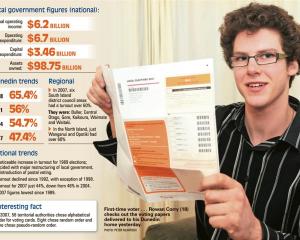Another Dunedin City Council ratepayer satisfaction survey has rolled around and another line-up of results has been produced.
Once again, the council and the interested public try to draw inferences from the responses.
Once again, some explanations are obvious, some results make little sense and a few are interesting.
In most instances, there is little change from previous years.
These days, and thanks especially to the requirements of the Local Government Act, the council is under obligation to try to gauge what the citizenry thinks.
The survey supposedly is to help guide the council on where it puts its resources, to examine any trends and to mark areas where improvements are needed.
But how much reliability can be given its results when only 922 questionnaires were returned from the initial mail-out of 4500? Through the agency of a second mail-out, a further 639 responses came in.
Concerning also, as Dunedin Ratepayers and Householders Association chairman Syd Adie said, are the large number of "neither satisfied nor dissatisfied" responses.
Apathy does rule in so many cases in local government, but this is particularly the case in response to the fundamental question about the overall performance of the council.
Those not willing to express a view for or against totalled 35%, not far behind the respectable 40% satisfied or very satisfied and the 25% dissatisfied or very dissatisfied.
Additionally, 9% of the overall returned questionnaires did not respond to this query, and there was sufficient indifference for nearly 3000 people not to fill out and mail back the questionnaire at all.
To what must be the council's frustration, some of this is symptomatic of a society with less interest in matters political at national and local levels, and less concern about community matters in general.
At least the council has received deserved and decisive feedback through the negative response to the processing of building consents, an area it has acknowledged needs attention.
Perhaps, though, the heavy criticism on the issue of attracting businesses and jobs to Dunedin, and retaining existing jobs and businesses, is more a reflection of well-publicised mass redundancies than anything that council staff are or are not doing.
The fact that ratepayers fund many services they do not use is illustrated by the "use of facilities" table.
Even the libraries and Otago Museum were not visited even once by more than half of the sample, 57% and 55% respectively.
The council is, indeed, a long, long way from "user-pays" in most of its activities.
The chief executive, Jim Harland, makes a good point when he explains that submitters to annual plans are not necessarily representative of the community, although he should be careful not to downplay the importance of them and their part in council decision-making.
Submitters tend to be those with the strongest opinions and often represent particular interests, whereas the "silent majority" might never be heard.
Also, many of that "silent majority" may very well agree with some of the council's more persistent critics.
Given Mr Harland's view, too, it is pertinent to ask why a direct question on the planned Awatea St stadium - the dominant issue before the city - was not included.
While a question about what residents would liked changed about the city's sport and recreation facilities prompted 97 to say they did not want a stadium, and 59 to say they did, that is a response of little value against the 1561 questionnaires returned.
Councillors and the mayor should not ignore the submitters or the survey but should, nevertheless, examine each issue they face with their own research and consultation, their own consciences and their own best judgement on what they believe is best for Dunedin.
They will then make well-founded decisions knowing they hold their positions at the behest of - and on behalf of - ratepayers and residents.
And another thing
Ratepayers will be pleased to see the early results from attendances at the Dunedin Chinese garden are showing great promise, especially as much of the period was one of inclement weather.
If, as the projections now suggest, more than the budget can be covered by revenue, the hope that the garden can be self-sustaining will be justified.
It will be very good news indeed for the city if the garden turns out to be a success story on the scale of the Otago Museum's tropical forest feature.



